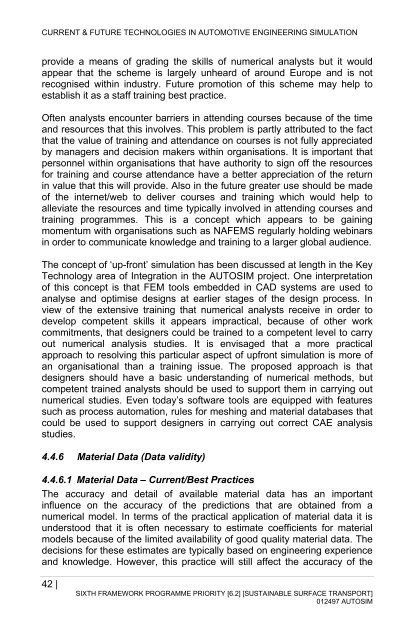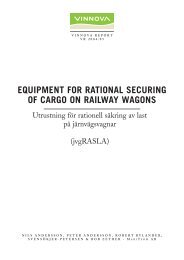Download - Autosim Autosim
Download - Autosim Autosim
Download - Autosim Autosim
You also want an ePaper? Increase the reach of your titles
YUMPU automatically turns print PDFs into web optimized ePapers that Google loves.
CURRENT & FUTURE TECHNOLOGIES IN AUTOMOTIVE ENGINEERING SIMULATION<br />
provide a means of grading the skills of numerical analysts but it would<br />
appear that the scheme is largely unheard of around Europe and is not<br />
recognised within industry. Future promotion of this scheme may help to<br />
establish it as a staff training best practice.<br />
Often analysts encounter barriers in attending courses because of the time<br />
and resources that this involves. This problem is partly attributed to the fact<br />
that the value of training and attendance on courses is not fully appreciated<br />
by managers and decision makers within organisations. It is important that<br />
personnel within organisations that have authority to sign off the resources<br />
for training and course attendance have a better appreciation of the return<br />
in value that this will provide. Also in the future greater use should be made<br />
of the internet/web to deliver courses and training which would help to<br />
alleviate the resources and time typically involved in attending courses and<br />
training programmes. This is a concept which appears to be gaining<br />
momentum with organisations such as NAFEMS regularly holding webinars<br />
in order to communicate knowledge and training to a larger global audience.<br />
The concept of ‘up-front’ simulation has been discussed at length in the Key<br />
Technology area of Integration in the AUTOSIM project. One interpretation<br />
of this concept is that FEM tools embedded in CAD systems are used to<br />
analyse and optimise designs at earlier stages of the design process. In<br />
view of the extensive training that numerical analysts receive in order to<br />
develop competent skills it appears impractical, because of other work<br />
commitments, that designers could be trained to a competent level to carry<br />
out numerical analysis studies. It is envisaged that a more practical<br />
approach to resolving this particular aspect of upfront simulation is more of<br />
an organisational than a training issue. The proposed approach is that<br />
designers should have a basic understanding of numerical methods, but<br />
competent trained analysts should be used to support them in carrying out<br />
numerical studies. Even today’s software tools are equipped with features<br />
such as process automation, rules for meshing and material databases that<br />
could be used to support designers in carrying out correct CAE analysis<br />
studies.<br />
4.4.6 Material Data (Data validity)<br />
4.4.6.1 Material Data – Current/Best Practices<br />
The accuracy and detail of available material data has an important<br />
influence on the accuracy of the predictions that are obtained from a<br />
numerical model. In terms of the practical application of material data it is<br />
understood that it is often necessary to estimate coefficients for material<br />
models because of the limited availability of good quality material data. The<br />
decisions for these estimates are typically based on engineering experience<br />
and knowledge. However, this practice will still affect the accuracy of the<br />
42 |<br />
SIXTH FRAMEWORK PROGRAMME PRIORITY [6.2] [SUSTAINABLE SURFACE TRANSPORT]<br />
012497 AUTOSIM
















